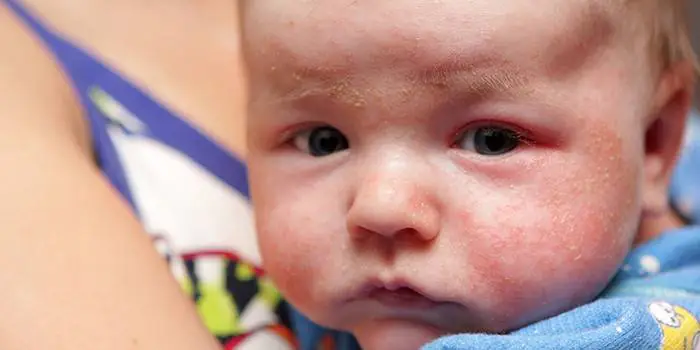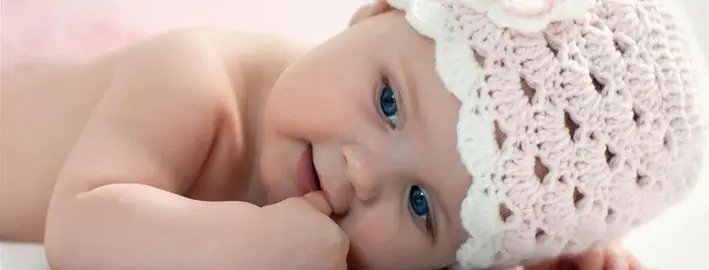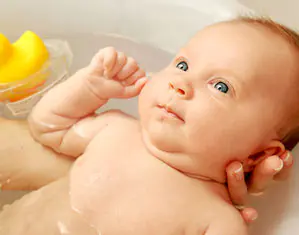Peeling of the skin accompanied by redness is one of the most common complaints with which young mothers turn to the pediatrician. Such problems arise both during the neonatal period and in the subsequent months of the child’s life.
Peeling skin in a newborn is quite common and in most cases does not require any medical treatment. But there are also exceptions.
Causes of peeling skin in infants

The baby is born into the world covered with vernix. This is a special grayish substance that is formed during its intrauterine development. This is what makes it easier for the baby to pass through the birth canal.
Relatively recently, the baby was wiped after birth, completely cleansing the skin. Today, vernix is most often left to allow it to be absorbed into the baby's skin.
But even in this case, the child’s skin begins to peel off. Sometimes the process is so active that it scares the baby’s mother. Causes of peeling skin may include:
Adaptation of the child’s body to completely new conditions
After birth, the child is forced to adapt to survival in completely new conditions. This concerns not only the body, but also the skin of the baby. They come into contact with air, fabrics, diapers and the reaction can be completely different. But gradually everything returns to normal, and the skin becomes smooth. So if the baby has peeling, but the baby does not show signs of concern, then everything is normal and there is no reason to worry.
The air in the children's room is too dry
It is because of insufficient air humidity in the room where the child spends most of the day that peeling of the skin is observed. The norm is considered to be air humidity in the range of 55...70%. Only in such conditions will the baby be comfortable (the skin will be able to maintain the required level of moisture).
If the air in the room is not sufficiently humidified, you can bring a container of water into the room and let it evaporate freely. But it is very important to monitor the indicators, since too humid air is also not very good.
It is especially important to maintain an optimal level of air humidity on hot summer days and throughout the heating season.
Improper skin care for babies
A huge mistake for parents is regularly bathing their newborn baby in water with the addition of potassium permanganate, since such procedures dry out the surface of the skin quite strongly. Of course, this will be useful for healing the umbilical wound and preventing the addition of a secondary infection, but it is too much stress for the baby’s entire body.
A newborn should be bathed in settled, pre-boiled water without adding any herbal decoctions, as this may cause the child to develop an allergic reaction. Later, when the baby's skin adapts to the environment, herbal infusions can be used. It is also advisable to use baby soap no more than once a week, as it can also be very drying to the skin.
After bathing, you need to examine your child's skin. If rashes or flaky areas appear, you need to change the soap and shampoo used when bathing your baby. It is likely that this is a manifestation of an allergic reaction to these particular cosmetics.
Skin response to external factors
The skin of a newborn baby is very delicate and actively reacts to any irritation. Quite often, peeling of the skin occurs after the first walk, when the baby first encounters direct exposure to air. That is why until the adaptation process is completed, the baby must be protected from the effects of any natural factors.
Why does the skin on a baby's body peel off?
The appearance of flaky areas on a child’s body is, in most cases, a reaction of the child’s body to a negative impact. That is why it is important to establish the true cause of such a deviation and, if necessary, take action.
Very often, prolonged peeling, accompanied by the appearance of redness, is caused by an allergic reaction or the development of diathesis. In addition, the condition can be provoked by gastrointestinal problems, viral or fungal infections.
And if the child’s well-being worsens and the baby’s negative symptoms increase, the baby should be shown to a pediatrician. After the tests, the baby will be prescribed treatment appropriate to the condition.
Why does the skin on my baby's head peel?
Very often, the cause of the appearance of flaky areas on the scalp of a newborn baby is the development of seborrheic dermatitis. The condition can develop around the second or third month of a baby’s life and goes away without any treatment by the age of one year.
The development of seborrheic dermatitis is caused by the immaturity of the sweat and fat glands. It is the excessive production of sweat and sebum that causes flaking of the baby's scalp. By the end of the first year of life, the glands begin to function normally, and the symptoms of the disease gradually disappear.
But if the signs of seborrheic dermatitis persist even after the baby is one year old, then it is necessary to consult a specialist. It is likely that the child has pathologies of fat and sweat glands, disturbances in metabolic or endocrine processes.
Why does the skin on my child's eyebrows or forehead peel off?
The main reasons that can provoke peeling of the eyebrows and forehead are:
- exposure to adverse weather factors - sun rays, cold wind, frost;
- infection;
- allergic reaction.
To identify the true cause, it is necessary to analyze the following points:
- duration of peeling;
- the time of its occurrence.
It is quite possible that the period when peeling began occurred when a new dish was introduced into the diet of a baby or a nursing mother. Sometimes this is how the baby’s body reacts to drug treatment.
In any case, if symptoms persist for a long time, the child must be shown to a pediatrician. The specialist will give appropriate recommendations.
What can you do if your child's skin is peeling?
First of all, it is necessary to exclude the possibility of developing any disease.
If peeling is the result of exposure to external factors, then you can use the classic recommendations of pediatricians.
If your baby's skin has lost its velvety quality and become dry, you can use baby creams with moisturizing properties. Cosmetic oils, also intended for infants, also have a good effect. You can use them after swimming and before going for a walk.
But there are situations when it is the use of children's cosmetics that causes peeling of the skin in infants. In such cases, in order to avoid the development of an allergic reaction, all creams can be replaced with sterilized olive or vegetable oil. To do this, you need to warm the product well using a “water bath”.
If your baby's skin peels off in response to exposure to sunlight, i.e. reacts specifically to ultraviolet radiation, it is recommended to use sunscreens designed specifically for infants. The products should be used before going for a walk with your child.
It is important not to go out into the open sun in the morning and afternoon. It is best to move walks to the afternoon. It is advisable to dress the baby in light clothes with long sleeves so that they completely cover the arms.
After bathing, the child's body should be wiped dry, not allowing the moisture to evaporate naturally. Because this can also cause peeling.
Infants often experience problems with the skin - redness, inflammation, allergic reactions. If a newborn's skin is peeling, it needs to be moisturized using special products; this problem can occur in a child for various reasons. Peeling in a baby may appear as a reaction to a new environment, dry air, or clothing made from artificial fabrics.
What is peeling skin in a newborn?
Sometimes this type of irritation can be confused with other more or less dangerous diseases, so you need to know what peeling looks like. If your skin is peeling, you may notice the formation of small dead white skin particles in areas of dryness. At the edges they may have a yellow tint and a compacted structure and vary in size. For example, flaking caused by extreme dry air resembles dandruff, and particles fall off when touched.
The scales can be removed with a comb or a damp cloth, but to prevent them from appearing again, it is necessary to eliminate their cause - excessive dryness of the skin due to external irritants. Sometimes, at the places where these scales form, you can notice small wounds that can leave traces of blood. This suggests that the baby was combing them. Peeling can occur on any part of a child's skin.

Symptoms
If the skin of a newborn is peeling, this is determined by the following external signs:
- odorless white or yellow crusts form;
- the baby behaves anxiously because the peeling causes itching;
- in the initial stages, when the scales are very small or there are few of them, particles similar to dandruff can be found in the baby’s crib.
If the cause is an adaptation period, peeling lasts about 4 weeks, if an allergic reaction, it is accompanied by redness or swelling. Symptoms of peeling appear immediately. In the early stages they are weak and characterized by small white particles. If the dryness is not eliminated, the peeling will increase and spread throughout the baby’s entire body, the dryness will progress, and the crusts will turn yellow. Sometimes you can even notice small bruises in the areas of exfoliation.
Why does a newborn's skin peel?
The reasons for this problem are varied. The main ones are:
- Improper skin care for a newborn - the skin of a baby is very delicate and requires careful care. Under no circumstances should you bathe your child too often - for example, after every walk - and you should not add a solution of potassium permanganate to the bath, because it can dry out the skin.
- Adaptation period - after birth, the baby’s delicate skin adapts to new conditions, clothes, and sometimes this is accompanied by small rashes that will go away on their own.
In addition to these two reasons, allergic reactions or skin diseases also occur. In such cases, the problem is serious, accompanied by yellow crusts with traces of blood, this requires urgent examination by a doctor and treatment. This dry skin can also be a reaction to very dry air due to the battery, frequent bathing in hard water or cold wind.

On the body
When examining the baby’s skin, the mother may notice small flaking and dryness on the baby’s legs and arms. This indicates the passage of an adaptation period, when the skin and mucous membranes get used to new environmental conditions, diapers, and hygiene products used. Dry skin caused by this reason ends very quickly on its own.
If, after regularly moisturizing the epidermis, dryness does not go away, and peeling worsens, this may not be a sign of adaptation, but the presence of infections, fungi, inflammation or allergic reactions in the baby’s body. To eliminate all dangerous consequences, you should immediately contact your pediatrician and undergo an examination. Severe peeling with purulent discharge indicates a neglected condition.
On the head
Sometimes a baby may have flaking on the scalp: they are similar to seborrhea or dermatitis in adults. If the skin on a baby's head is peeling, this is mainly a natural process of renewal of the body. At this age, babies develop and grow very quickly, and the skin renewal system also works quickly. New cells grow, and old ones fall off and remain on top in the form of white or yellow crusts.
To get rid of these manifestations, you need to bathe the child in warm water, and if crusts remain, carefully comb them out with a comb. If the problem does not go away for a long time, you need to take the following measures:
- change the powder and conditioner for washing baby clothes;
- purchase a device that will humidify the air;
- Stop bathing your baby in hard tap water and try to use boiled water.
On the forehead
Excessive peeling of a newborn's skin is normal throughout the body. Young parents are often worried if the skin on the baby’s forehead is peeling; dryness can also spread to the bridge of the nose and eyebrows. The causes of peeling on the forehead of a newborn is postpartum adaptation of the skin, which is normal. These peelings can last up to 8 months, in rare cases longer, up to 3-4 years.
In order not to further damage the delicate skin of the baby, it is not recommended to remove these crusts. Under no circumstances should you comb or pick - you can cause an infection and severely injure the skin. It is best not to touch the crusts; after bathing they will come off on their own. But, if they interfere too much, you can soften them with baby oil heated in a water bath and remove them with a damp cloth.

What to do if your skin is peeling
If the baby has strong crusts and they need to be removed, you need to do this very carefully. If a newborn has flaking on the head, for a better result, you can apply a moisturizer, put a cap or towel on the head and leave for 20 minutes. Then the baby needs to be bathed and the softened crusts will disappear. The procedure can be performed daily. The use of sharp combs is strictly prohibited; they can injure already delicate and inflamed skin.
Dry skin in babies can be removed with the help of cosmetic baby creams. You can use them morning and evening to prevent unpleasant flaking from increasing. Such care should not be carried out very often, so as not to aggravate the skin condition and increase dryness. Remember: if you bathe your child often, the poor functioning of the sebaceous glands will become even worse.
Care instructions
Daily baby skin care should include gentle cleansing and moisturizing. It is not necessary to bathe your baby every day. If your baby's facial skin is peeling, you need to take a cotton swab, soak it in warm water and wipe the skin, gradually removing the crusts. After cleansing, you need to apply a moisturizing baby cream, which will have a softening effect. Instead of bathing with water, it is recommended to use baby wipes; they can also be used after using the toilet. It is better to give preference to napkins that do not contain
Prevention
To keep your newborn's skin smooth, healthy and soft, you need to follow these important rules:
- You can start active bathing 1.5 weeks after birth, so as not to wash off the protective layer;
- choose products without lanolin, silicones and parabens;
- baby soap should be used no more than 2 times a week;
- monitor your diet - the composition of breast milk depends on the mother’s diet; during breastfeeding you need to stop consuming allergenic foods;
- If the indoor air is dry, if possible, it is better to purchase a humidifier.

A long 40 weeks of waiting, and now your baby is with you. You expected to see him beautiful, pink, but he turned out to be wrinkled with puffy eyes and red skin. Childbirth is a serious test not only for the mother, but first of all for the little person.
He finds himself in a completely new environment, with completely different conditions. Every new person undergoes adaptation. At this time, various problems arise. One of the most common is flaking skin in newborns. You must help your child and create the most comfortable conditions for him.
Causes
Why does a newborn's skin peel? The main reason is adaptation to the outside world, which is harsher than life inside the mother. For 9 months the little man was in a warm liquid, completely covered with vernix lubrication - the best protective material, there was no talk of any peeling.
It is much colder outside, the body is constantly in contact with clothing, dry air, and water. There are a number of factors that increase the likelihood of flaking of a newborn’s skin:

- Errors in your diet (if you are breastfeeding); Read the article for more details about nutrition for a nursing mother>>>
- The air is too dry. To avoid peeling of the newborn’s skin, the humidity in the room should be maintained at a level of at least 50%;
Unfortunately, in modern apartments this figure is much lower. The situation worsens during the heating season, when the air is dried by radiators.
To find out whether the skin on your newborn’s body is peeling is a consequence of dry air, purchase a special device for measuring humidity - a hygrometer. Read more about this: Temperature in the room for a newborn>>>
Another result of a lack of moisture in the room is dry nose, which can lead to disturbances in the newborn’s breathing, sleep, and mood.
- Care errors. For a long time, pediatricians advised bathing newborns in water with the addition of potassium permanganate to speed up the healing of the umbilical wound;
Sometimes, in pursuit of cleanliness, mothers too often use soaps, gels, and shampoos when bathing, which dry out the newborn’s skin, increasing the likelihood of peeling. The widely used decoction of string often has the same effect. Read this useful article: What herbs can you bathe a newborn in?>>>
- Allergy. Some hygiene products (shampoos, washing powders) cause allergic reactions and peeling. It's not that the product is bad. Each person is individual, and what suits one newborn may cause severe peeling in others;
- If your newborn has flaky scalp. This is most likely the result of excessive activity of the sebaceous glands. Such peeling occurs frequently and in some cases disappears on its own; Read more about crusts on a baby’s head>>>
- Reaction to the weather. In the cold season, during a street walk, wind and low temperature can cause peeling in a newborn. And the hot summer sun often causes a reaction on the skin.
How to help
What to do if your newborn's skin is peeling?
There is no need to take complex special actions if nothing bothers the child. If peeling does not cause problems with sleep or mood, you can simply wait until the skin adapts.
But if concern arises, the problem must be addressed. The principle is simple:
- Find the suspected cause of peeling;
- Eliminate;
- See if the baby's skin condition changes.
- If peeling occurs due to allergens in your menu, eliminate them. Analyze the foods you eat, find out what exactly could cause a reaction on the skin;
- If peeling occurs due to dry air, it needs to be moistened. There are special devices - humidifiers, which automatically maintain the required level of humidity in the room where the newborn is. This will help avoid or eliminate peeling;
If you can’t buy a device, increase the humidity yourself: do wet cleaning several times a day, place containers of water around the room, hang wet towels and sheets over hot radiators.
- If the problem is due to improper care, eliminate all products that can cause flaking and dryness of the newborn's skin. When washing, use shampoo, soap, gel only once a week, remove potassium permanganate away. To avoid peeling, bathe your newborn in plain water without additives;

If the water quality is poor, boil it first. This should be done only in the first month, until the umbilical wound heals and the baby adapts to some extent to the outside world. You can add chamomile decoction to the water; this herb does not cause dryness or allergies, softens the water, and helps eliminate flaking in a newborn.
- Monitor reactions to cosmetic products. If, after using shampoo or bathing foam, the skin on the legs, arms or other parts of the body peels off, change the brand and manufacturer;
Choose cosmetics without dyes or strong odors. Strong-smelling laundry detergents and gels are also likely to cause allergies in your newborn. Peeling on the skin may appear upon contact with clothing. Therefore, be very careful when choosing a powder or fabric softener.
Change manufacturer if necessary. Skip the conditioner to reduce the likelihood of flaking. Rinse baby clothes several times (set the washing machine to the “extra rinse” mode).
- If the skin on the baby's head peels, do not touch the crusts that have formed and do not injure the newborn's skin. Infection can enter the body through microcracks. If peeling bothers your baby or you really don’t like it, use products to soften the crusts after bathing. For example, Vaseline or vegetable oil. After some time, carefully remove the scales;
- If your newborn's facial skin is peeling due to wind and cold, make sure that your baby is protected from the weather during walks. Half an hour before going outside, smear your child’s face with a special protective cream. In summer, avoid prolonged exposure to the sun. For delicate baby skin, this can have unpleasant consequences in the form of peeling.
Use protective products with a UF filter (cream, lotion, milk) designed specifically for children. As a rule, such cosmetics have a high degree of protection. Remember that it is not only the head and face that should be protected; often, after exposure to the sun, the skin on the hands of a newborn peels off. This part of the body is usually not covered by anything.
If the exact cause of peeling is unknown, you need to create the most comfortable conditions for the newborn’s skin, that is, take into account all factors. This will help overcome peeling, and your baby will be healthy and cheerful.



